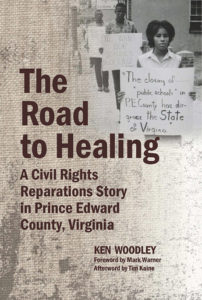The Road to Healing: A Civil Rights Reparations Story in Prince Edward County, Virginia
Reviewed by Patience A. Schenck
April 1, 2020
 By Ken Woodley. NewSouth Books, 2019. 224 pages. $27.95/hardcover; $9.99/eBook.
By Ken Woodley. NewSouth Books, 2019. 224 pages. $27.95/hardcover; $9.99/eBook.
What do reparations for racial injustice look like? As we publicly discuss reparations for centuries of slavery, discrimination, and mass incarceration in America, it is helpful to learn about the first civil rights-era reparation for racial injustice in U.S. history. It happened in 2004, as related in The Road to Healing: A Civil Rights Reparations Story in Prince Edward County, Virginia.
In 1959, as increased pressure was put on states to integrate their public schools, the Prince Edward County Board of Supervisors in Virginia chose to close all their public schools and use state tuition grants to send White children to all-White private schools. The family-owned local newspaper, the Farmville Herald, backed this move enthusiastically, as did most leading White citizens. The result was that 2,202 Black children received little or no local public education at all for five years, and in many cases, they were never able to make up the deficit. A few children were sent to live with relatives in other places or to volunteer families in the North, thus uprooting and even traumatizing the children and their families.
Ken Woodley, the author of this book, knew nothing of this history when he was hired by the Farmville Herald as a reporter in 1979. He became editor of the paper in 1991. By then he had learned of the closings, and he felt a strong spiritual call to do something concrete to address the injustice. A public apology had been made, but that did nothing to address the educational deprivation of the casualties. Woodley’s idea was to lobby the Virginia legislature to create the Brown v. Board of Education Scholarship Program and Fund for the casualties of the school closings, now in their 50s and 60s, to allow them to continue their education. Because their children and grandchildren grew up in homes headed by illiterate or poorly educated people, which surely affected their educational achievement, he hoped the program would be extended to them as well.
Using his position as editor of the newspaper for a bully pulpit both to publicize his idea and to gain access to the governor and legislature, Woodley lobbied hard for funds for the scholarship program in 2003 and 2004. Unfortunately, a budget crisis posed a significant barrier. Ultimately, however, Virginia philanthropist John Kluge pledged $1 million to the cause and the state legislature matched it. The support for the program from both political parties was almost universal. The program would help the victims of the closings, though unfortunately not their children and grandchildren.
Some casualties of the closings felt it was too late for them, but as of the publication of this book in 2019, an estimated 250 people had been served by the fund. They used the funds for purposes ranging from literacy tutoring and GED classes to career and technical education, undergraduate, and even graduate education. It’s clear that the entire Black community appreciated that justice was finally being done. Many were willing to travel to Richmond, Va., to testify before committees on their own experiences of deprivation.
I was inspired by the example of what one determined person can accomplish. Woodley devoted his time and resources to the campaign with dogged persistence for two years. The result was further education for 250 people and a sense of healing between the Black and White communities of Prince Edward County and the larger Commonwealth of Virginia.
People familiar with Virginia politics and others who work for legislative change will appreciate the detailed description of meetings with committee members, phone calls made, and faxes sent. I would have prefered less detail, as I think would be the case with most readers who simply want to know what was accomplished and how it affected the community.
Where do we go from here? The author and force behind this first act of reparation suggests a massive investment targeting our inner cities and rural communities with significant African American populations to focus on education, healthcare, housing, economic development, and infrastructure. He suggests that within these communities, this “domestic Marshall Plan” would include members of all races, which he believes would increase public and political support while fostering racial reconciliation. This plan gives us a starting point for discussions as we consider how to repair the harm done to a significant portion of our population over several centuries.



Comments on Friendsjournal.org may be used in the Forum of the print magazine and may be edited for length and clarity.